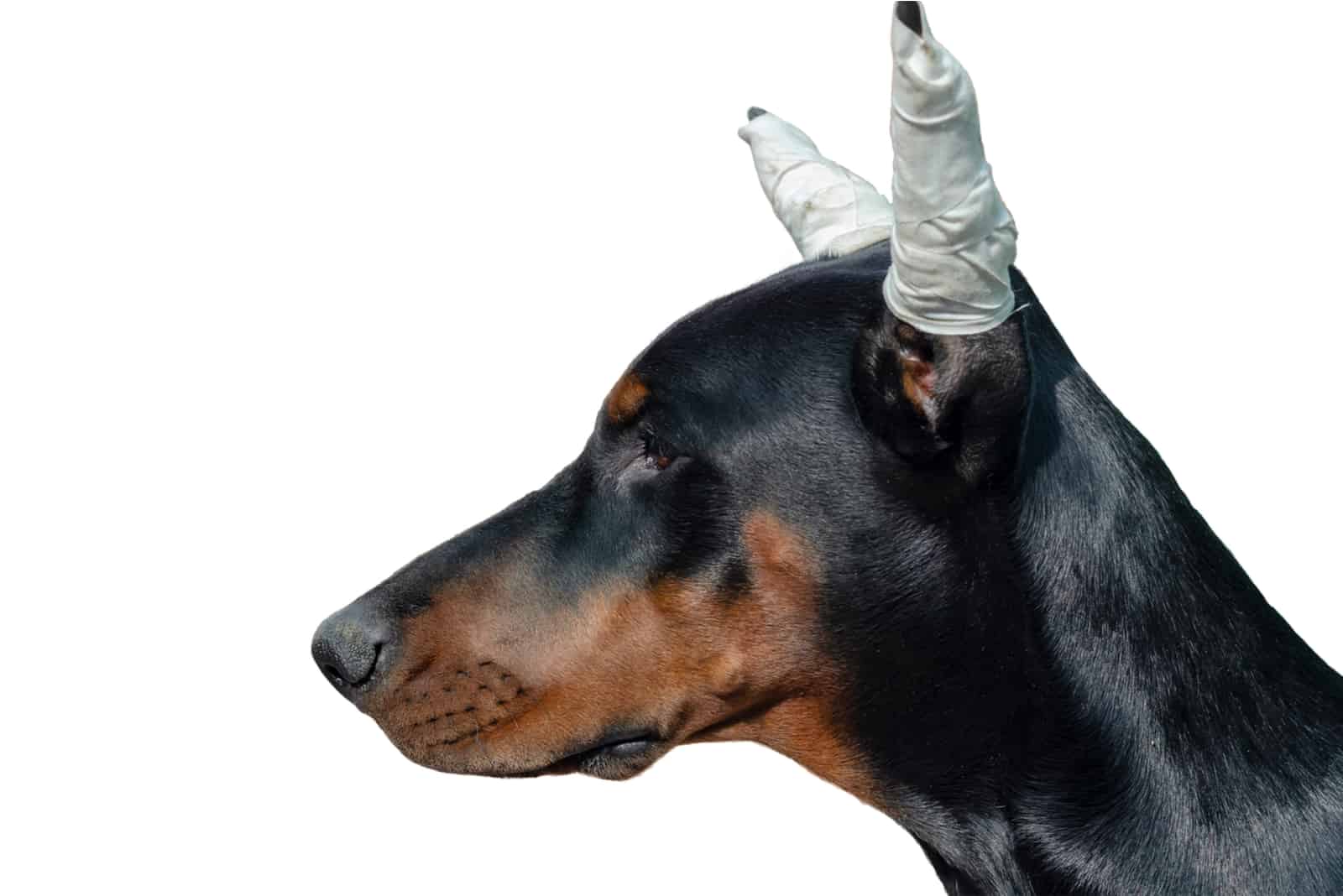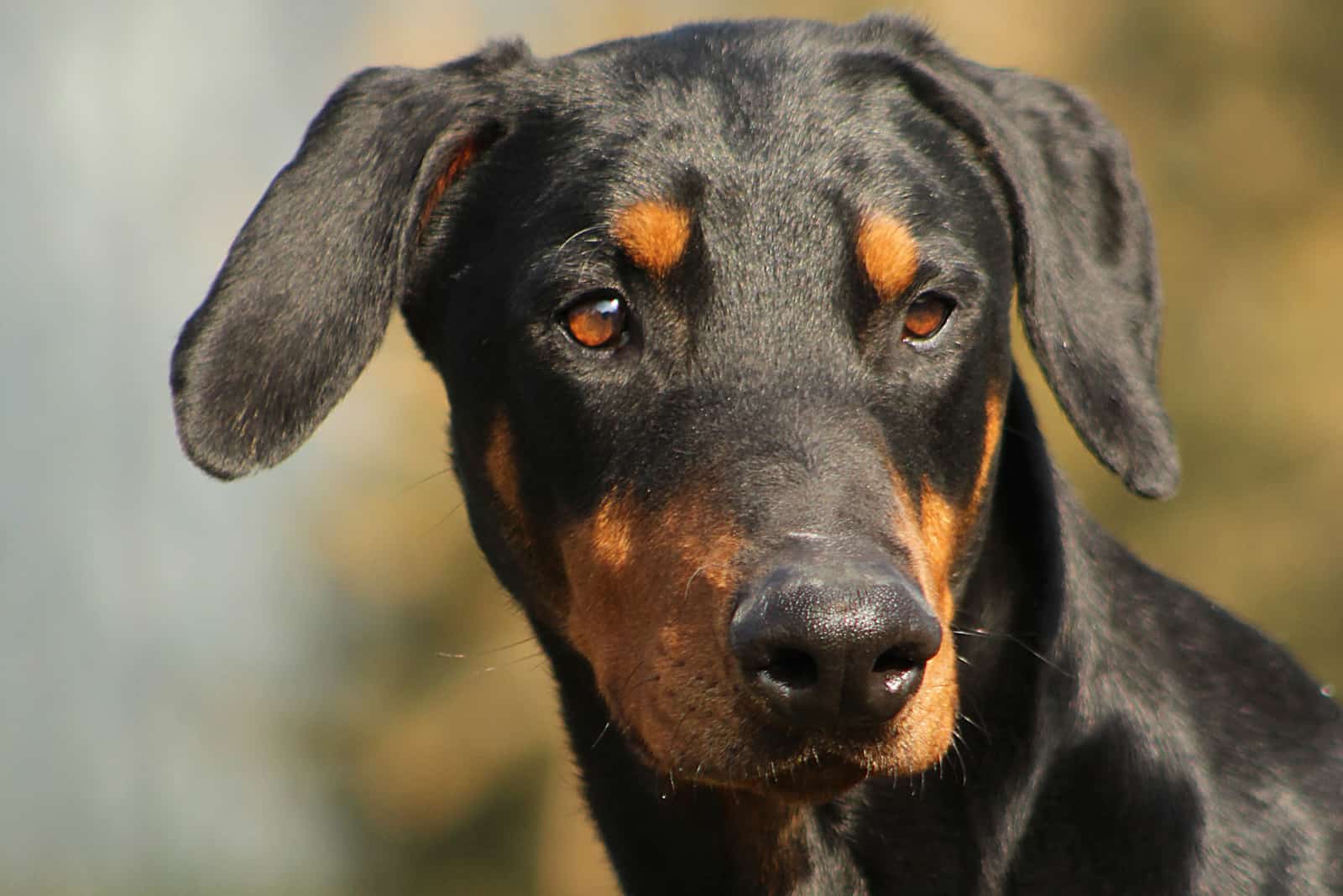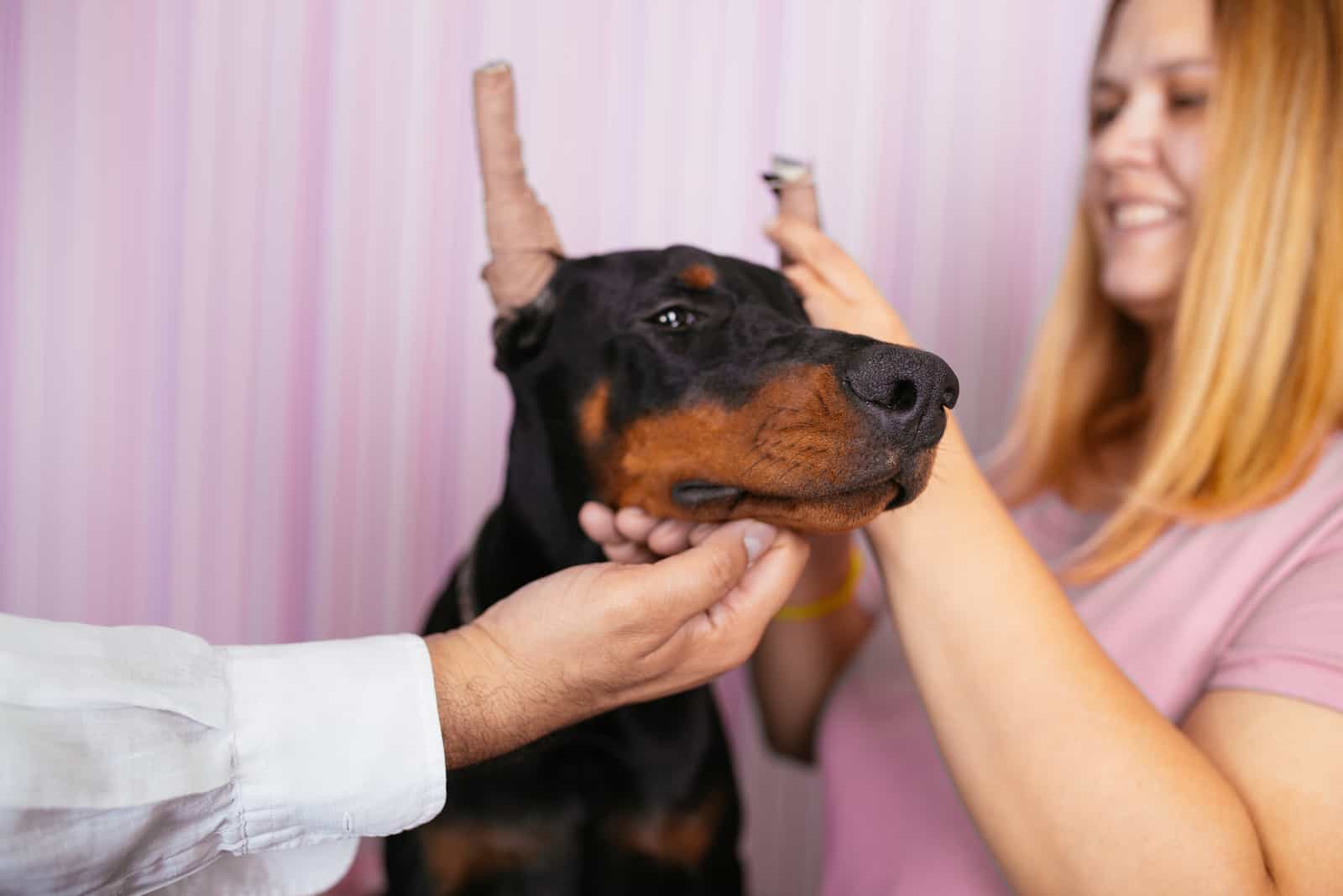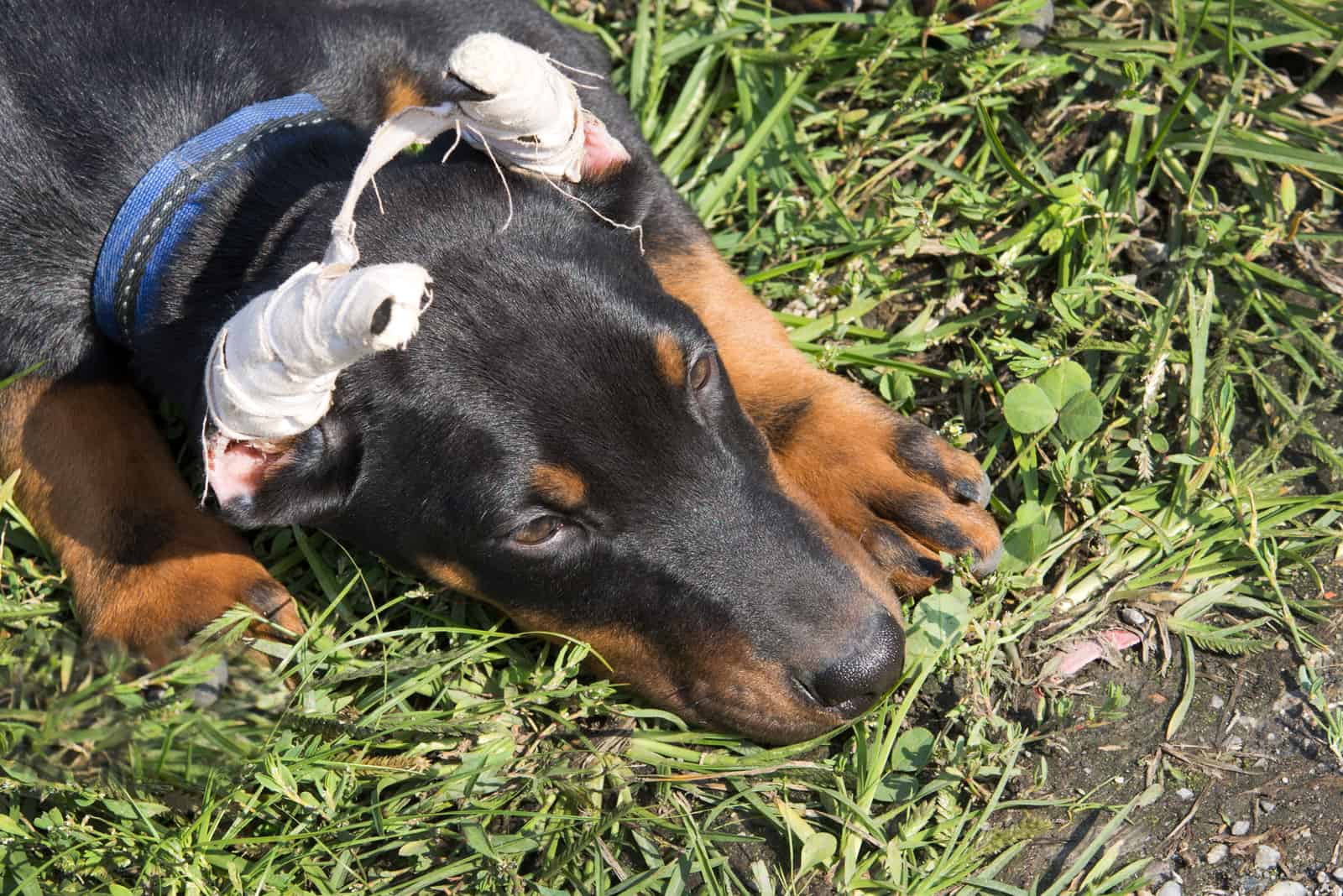The Doberman breed (also spelled Dobermann) has a striking appearance. It is sleek, athletic, and muscular. It has an intimidating presence, waiting silently and patiently as it guards its home and family.
Many of us imagine them with their classic features of a long muzzle and sharp, pointed ears.
It comes as a shock to some people when they discover that those pointed ears aren’t natural. Doberman ears are naturally floppy as you can see when they are puppies. To achieve the sharp-eared look, pups have to go through surgery and months of recovery.
This is a controversial and emotive subject that still causes much debate today. It isn’t just the Doberman that’s affected. Other dog breeds also continue to be mutilated this way, including the Cane Corso, the Boxer, the Pit Bull, the Great Dane, and the Schnauzer.
So, what’s the truth? Does it hurt the pups? Are there any real benefits? Should this practice be banned?
We’re going to look at both sides of the issue of Doberman ear cropping to help you make up your mind on the matter.
Why Cut Doberman Ears?

This isn’t really a subject where you can sit on the fence. You’re either okay with it or you think it’s wrong. To get the full picture of why people think the way they do, we need to listen to all the arguments.
To start us off, we’re going to look at the reasons given in favor of ear cropping.
First and foremost, it’s about breed standards. Many dogs that have their ears cut were once working dogs or fighting dogs. Floppy ears got in the way and could be injured, so they were regarded as a weakness and were removed. People accepted that this is how the dogs looked, and it became traditional to crop the ears of certain breeds.
Breed standards are set by organizations like the American Kennel Club (AKC) and parent breed clubs. These are established to preserve the look of a particular breed, especially for dog shows. They often include a clause about cropped ears, and until recently, a Doberman with uncropped ears would be penalized in a show because it did not conform to the standard.
In recent years, the AKC has softened its stance slightly, instructing judges not to penalize natural ears. However, they actively oppose any attempt to change the legislation regarding ear cropping.
Aside from conforming to breed standards, proponents of ear cropping claim that it improves the dog’s hearing and reduces ear infections. We’ll look at these claims in more detail later.
When Do Dobermans Get Their Ears Cropped?

Usually between the ages of 6 and 12 weeks, for both male and female dobermans.
After this time, the cartilage starts to harden, making it unlikely that the ears will stand upright. Some breeders have their pups’ ears cropped as a matter of course, so you might want to advise the breeder that you want your pup’s ears intact and natural before this takes place.
If the breeder refuses and insists that the pup comes cropped and docked, then you’d be wise to find another breeder who is more flexible if you prefer a Doberman with uncropped ears.
How Are Doberman Ears Cropped?
The ear cropping procedure is classed as elective surgery, although it is really a form of cosmetic surgery.
Where the practice is still legal, it must be performed by a qualified, licensed veterinary surgeon.
The surgery takes place under general anesthesia, and lasts about 30 minutes. During the process, the large floppy part of the dog’s ear is sliced off. There are three basic cropping styles: military, show, and medium crop depending on the desired look.
After surgery, the pup’s ears are taped to a foam support (usually a styrofoam cup!) or a plastic rack for between four and six months while they heal. In some cases, it may take up to a year. Once the tape is removed, the ears should stand upright of their own accord.
Do Doberman Ears Naturally Stand Up?

No, Doberman ears are naturally floppy and will always be so without human intervention.
Some dog owners try to tape the ears without surgery, but this will fail every time. Aside from being pointless, it can be uncomfortable or even painful.
The point to consider here is that the Doberman’s naturally floppy ears are the result of decades of selective breeding. All dogs are related to the wolf, sharing more than 99% of their DNA. As we know, wolves have naturally pointed ears.
While some breeds retain this feature, many don’t. Recent research suggests that floppy ears in certain breeds are a result of domestication, connected with the adrenal gland and the fight or flight response.
Doberman Pinscher With Uncropped Ears

Photo from: @pepsithedoberman
There’s no denying that a Doberman with uncropped ears looks very different from one that has been cropped.
They almost appear to be different breeds, which is probably the main sticking point for those in favor of cropping. Some people love the pointy-eared look. Others like the fact that it makes the dog look intimidating and aggressive.
To be fair, this is true. The classic image of a Doberman with pointed ears gives the impression of power and confidence. Few intruders would attempt to take them on based on their appearance alone!
Does this mean that a Doberman with uncropped ears is any less of a deterrent? Psychologically, maybe. But, in reality, intruders are not going to think… well, it’s got floppy ears, so it won’t attack me! In support of this argument, we could consider the Rottweiler, which has never included ear cropping as part of the breed standard.
The truth is, a Doberman will protect its family and property whatever its ears look like.
Is Cropping Doberman Ears Cruel?

Yes. Without a doubt, ear cropping is cruel. While the surgery is sometimes painless as it’s performed under general anesthesia, this isn’t always the case. There are instances where the procedure is performed without any kind of anesthesia.
The healing process takes months, possibly up to a year. Don’t be fooled: this doesn’t just take away ‘useless skin’; it cuts through cartilage and thousands of nerve endings, too.
Pups need pain medication and a lot of aftercare to cope with this, as well as multiple dressing changes, which are usually very uncomfortable as the wound is disturbed yet again. There is a real risk of infection throughout this time. As well as being painful, infections can lead to sepsis (blood poisoning), which can cause multiple organ failure.
The American Veterinary Medical Association (AVMA) and the Canadian Veterinary Medical Association are opposed to ear cropping on the grounds that it is cruel and unnecessary, offering no health benefits to the dog.
This contradicts claims by proponents of ear cropping that it helps the dog to hear better, as well as reducing infections. In fact, there is zero scientific evidence to support either assertion. Statistics tend to show that ear infections are just as common in cropped ears as they are in uncropped ears. Also, many vets point out that floppy ears prevent debris from entering the ear, whereas an upright and open ear will allow more dirt to enter.
And, as for improving the dog’s hearing, the reverse is more likely to be true. Dogs have a lot of muscular control over their ears, and they are able to move them around in a range of different ways in order to catch sounds. Removing part of the ear restricts this movement. Dogs also use this as a means of communication, allowing them to read another dog’s body language. Taking away this ability leads to misunderstanding, confusion, frustration, and aggression.
One other consideration is that general anesthesia is always a risky procedure, which is the main concern of the AVMA. They question the ethics of elective surgery and anesthetizing an animal purely for cosmetic reasons. It takes around 3 or 4 days for the effects of the general anesthesia to wear off, during which time the pup can feel very sick.
In addition, the Doberman is just one breed that is prone to Von Willebrand’s disease; a bleeding disorder that causes the blood to stop clotting properly. This poses an added risk if the dog is subjected to surgery, or if the wounded ears become infected or damaged while healing.
How Do You Crop A Doberman’s Ears At Home

You don’t… end of story.
Anyone considering this needs to examine their conscience very closely. And, anyone who knows of a dog owner contemplating such a horrific action should report them for animal cruelty.
If you’re wondering why we included this alarming title for this section, you might be disturbed to learn that it appears in Google searches every month, and it showed up in the research for this article.
Ear cropping might be legal in North America, but it should only be performed under general anesthesia by a licensed veterinarian. The fact that there are people looking into a DIY approach to ear cropping speaks volumes about the pro-ear cropping camp. Sadly, as the practice dies out (which seems to be the case), there are dog owners who are willing to mutilate their own dog’s ears just to prove a point.
As we already learned, the AVMA is opposed to any surgical procedure for cosmetic purposes. Because of this, it is no longer taught in veterinary schools, and many vets refuse to perform these surgical alterations.
Eventually, the practice will die out and we will no longer expect these beautiful dogs to be mutilated simply to have erect ears. What’s clear is that stronger penalties will be needed to protect dogs against those who are willing to crop their dog’s ears behind closed doors or in backstreet ‘vet surgeries’. Supporters of Dobie ear cropping even use this as an argument in favor of it. Their reasoning seems to be that if licensed vets don’t do it, dog owners will do it themselves or get it done elsewhere illegally!
A Doberman With Uncropped Ears And Tail
https://www.youtube.com/watch?v=sLUK4_be2rc
Try Googling this title, or something like ‘Doberman natural ears’, and you’ll discover thousands of pictures of the Dobe in its natural form. They’ll have beautiful floppy ears and a long tail. However, as well as having their ears mutilated, these dogs are subjected to another type of amputation: tail docking.
It’s a shocking fact that millions of people assume that the Doberman is born with erect ears and a stump for a tail. They believe that individual dogs from the same litter can look very different… some with erect ears and no tail, and others with floppy ears and a tail!
This is not the case at all. Again, this is another form of cosmetic surgery that has been banned in many countries on the grounds that it is cruel and unnecessary.
As with ear cropping, those in favor of tail docking claim that it benefits the dog. They suggest that removing the dog’s tail prevents it from being injured.
However, the statistics simply don’t support this notion in any way: severe tail injuries are very rare in dogs that have not been docked.
Once again, the procedure is carried out when the pups are young; usually between 2 and 5 days. Unlike ear cropping, anesthesia is not usually given, so the pups will feel the scalpel blade or the scissors as they slice through the skin, muscle, and cartilage. Alternatively, a band is placed around the tail to cut off the blood supply. After a while, the tail will shrivel and fall off.
Fans of tail docking dismiss all this as ‘momentary discomfort’ as the pup’s nervous system hasn’t fully developed. In fact, the opposite is true as recent research proves that the pain is far more intense than in an adult dog as the neural pathways have not been properly insulated.

Far from being slightly uncomfortable, the pain is raw and agonizing, and many puppies scream during the procedure and will continue to cry for days afterward. Some breeders have abandoned the tail docking procedure because they couldn’t bear the sound of distressed pups.
The AKC and other kennel clubs, as well as many breeders and breed enthusiasts, will stick to their guns over this issue as they do with ear cropping. Their main argument is that this is the traditional breed standard, and that’s the way the dog should look.
What they fail to acknowledge is that dogs are born with tails for a good reason, as is the case with ears.
Tails are an essential part of a dog’s communication system. The position and speed at which the tail wags tell us (and other dogs) a lot about a dog’s mood, intentions, and temperament. Dogs without a tail are at a disadvantage, leading to frustration and misunderstanding.
Thankfully, you see a lot more dogs with tails these days. As with ear cropping, the docked tail is rapidly becoming a thing of the past as people begin to comprehend the cruelty involved. While there will always be a minority in favor of mutilation and amputation for the sake of tradition, the Doberman with uncropped ears and a natural tail will very soon be a common sight in America, as it already is in most forward-thinking countries.
Dobermans With Uncropped Ears: A Useless Guard Dog?

We alluded to this point earlier, but it’s worth revisiting as it raises some interesting points. Those who love the pointy-eared look of the cropped Dobe often suggest that natural ears just don’t look fierce or aggressive enough. They want a dog that looks intimidating as a guard dog; not some floppy-eared goofball. Surely, an intruder would just laugh at those ears?
This tells you a lot about humans: people are willing to artificially alter a dog’s appearance in order to make it look aggressive, even if that procedure is painful. We willingly compromise our pet’s welfare in order to achieve a particular look for them.
The connection between dogs and humans is long-established, and we have domesticated them over thousands of years. We’ve created hundreds of different breeds, changing the wolf into breeds as diverse as the Tibetan Mountain Dog and the Chihuahua. All of them come from the wolf.
We claim to love dogs, but we often view them as objects or possessions… things that can be altered and adapted to suit us and our lifestyles.
What we conveniently forget is that these are living, breathing creatures that feel pain, love, happiness, excitement, fear, and so on. Even when confronted with the truth, people will ignore it or reject it as it doesn’t fit their own narrow beliefs and opinions.
We need to think more carefully about this. We need to examine our actions and beliefs, and understand why we think we have the right to mutilate animals for our own satisfaction.
After all, how can we call ourselves dog lovers if we can so easily subject them to needless pain, suffering, and alteration? These aren’t simple procedures that benefit the dog, and they have no other impact on them. These are unnecessary actions that have a profound effect on the dog at the time, and for the rest of its life.
As for a Doberman with uncropped ears as a guard dog, its ability to remain alert and to deter intruders would be just as effective as one with cropped ears. The only difference is in the mind of the dog owner. And, if you want a mean-looking dog just to make you look tough, you don’t have any business owning a dog in the first place.
Should I get My Doberman’s Ears Cropped?

If you live in a country where it has been banned, the decision has been taken out of your hands. It hasn’t been banned in the U.S. (yet), but it’s surely only a matter of time.
So, should you get your Doberman’s ears cropped?
In the end, it’s your decision. However, the evidence is clear: ear cropping offers absolutely no benefits whatsoever, and it is a purely cosmetic procedure. It is extremely painful and uncomfortable for the pup, and carries many risks.
It’s also important to remember that the dog has no choice in the matter. This comes down to your judgment and whether you are willing to put them through this unnecessary pain, suffering, and risk essentially for your own satisfaction.
After all, a Doberman with uncropped ears is still an amazing dog, and will function just as well, if not better!
The Last Word On Ear Cropping (And Tail Docking)

Photo from: @nova.thedobie_
Just like any other dog, a Doberman puppy is a lovely thing. It has naturally floppy ears and a little, wagging tail.
At some point in the past, someone thought it was a good idea to cut off parts of those ears and shorten the tail. It became a tradition, and people accepted this new look.
The arguments for continuing these procedures are weak, insubstantial, flawed, and ultimately indefensible. The truth is that neither procedure offers any benefits to the dog. It’s all about keeping the look of the breed, and nothing more.
Ear cropping and tail docking are banned in most of Europe, the UK, New Zealand, and Australia (although there are some limited cases where tail docking is allowed for some working dogs).
It is time for kennel clubs, breeders, and breed fanciers to move into the 21st century. Animal welfare is high on the agenda for most people these days, with a definite move toward saving endangered wildlife and treating animals more compassionately.
This trend will surely continue, especially as people become more aware of the facts. Social media and websites have helped to spread the word, allowing people instant access to data and information. People can discover the truth from articles like this one, and decide for themselves.
So, armed with this information, you can make a choice before you get your Dobie. Will you look to the future and choose natural, floppy ears and a beautiful tail, or will you choose the cruelty that belongs in the past?
Read Next: Is American Bulldog Ear Cropping Necessary Or Ethical: The Whys And Why Not
